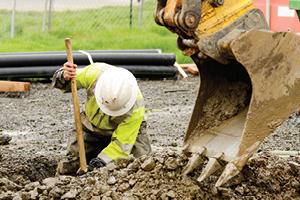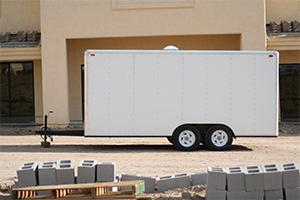Safety guidelines to protect people on and off the jobsite

Jobsite safety is about more than protecting workers. It's about protecting the public, and your business, too. Risk management efforts must be in place to address potential exposures and ensure work areas will not create uncontrolled hazards that may result in injuries to others. Make sure your business is protected with insurance coverage including general liability, workers’ compensation, commercial auto, commercial umbrella and more.
On-site guidelines
- All contractors should be required to maintain clean work areas by frequently removing debris and materials that could result in falling objects or slips/trips by others.
- When work is performed that could result in falling objects or tools, lower levels should be barricaded to prevent other workers from walking below.
- When work requires removal of protective controls such as guardrails or floor cover, the work area should be barricaded to keep other contractors out.
- When trucks are used for material delivery that require backing up, a spotter should be used when such operations are in congested work areas.
- Swing radius areas near cranes and other equipment should be barricaded to prevent workers from being struck by equipment.
- A site traffic control plan should be developed to allow for the safe flow of construction vehicles through the project.
- When work is near public walking areas, protection from building materials and tools falling from heights needs to be considered, including sidewalk canopies or rerouting sidewalk access.
- Nightly project exterior inspections should be conducted to ensure no slip/trip hazards are present on public walking areas.
- Proper signs/cones and flaggers should be available when offloading materials requires partial use of an active street near the project.
Off-site guidelines
- Work performed on streets and roads must follow a traffic control program that is designed per the manual of uniform traffic control devices (MUTCD).
- Only properly trained flaggers should be used to control traffic through work zones when required by MUTCD standards.
- Sidewalks near projects should be rerouted or closed to prevent the public from walking near equipment and hazardous work areas.
- When digging:
- Always use the 811 National One-Call Hotline or contact your state diggers number before any work disturbing the ground
- Train workers in emergency procedures should an underground utility be struck
- Assist utility locaters by “white lining” the dig area
- Always verify exact utility locations by potholing or daylighting
- Always look around the location for evidence of utilities that may not have been marked
- Always take photo/video of location marks/flags for documentation purposes before beginning your work
- Always instruct workers on emergency procedures for responding to a utility strike
- Always review the one-call ticket for “work begin date” and know for how long the ticket is valid
Our underwriting, claims and risk management professionals have worked with contractors for many years. We offer comprehensive solutions that are cost-effective and convenient. The Hanover Risk Solutions website has additional information that you can review or use for worker training.
This material is provided for informational purposes only and does not provide any coverage or guarantee loss prevention. The examples in this material are provided as hypothetical and for illustration purposes only. The Hanover Insurance Company and its affiliates and subsidiaries (“The Hanover”) specifically disclaim any warranty or representation that acceptance of any recommendations contained herein will make any premises, or operation safe or in compliance with any law or regulation. By providing this information to you, The Hanover does not assume (and specifically disclaims) any duty, undertaking or responsibility to you. The decision to accept or implement any recommendation(s) or advice contained in this material must be made by you.
LC 2017-423
May 2018
Related resources
Safety guidelines to protect people on and off the jobsite
Jobsite safety is about more than protecting workers. It's about protecting the public, and your business, too. Risk management efforts must be in place to address potential exposures and ensure work areas will not create uncontrolled hazards that may result in injuries to others. Make sure your business is protected with insurance coverage including general liability, workers’ compensation, commercial auto, commercial umbrella and more.
On-site guidelines
- All contractors should be required to maintain clean work areas by frequently removing debris and materials that could result in falling objects or slips/trips by others.
- When work is performed that could result in falling objects or tools, lower levels should be barricaded to prevent other workers from walking below.
- When work requires removal of protective controls such as guardrails or floor cover, the work area should be barricaded to keep other contractors out.
- When trucks are used for material delivery that require backing up, a spotter should be used when such operations are in congested work areas.
- Swing radius areas near cranes and other equipment should be barricaded to prevent workers from being struck by equipment.
- A site traffic control plan should be developed to allow for the safe flow of construction vehicles through the project.
- When work is near public walking areas, protection from building materials and tools falling from heights needs to be considered, including sidewalk canopies or rerouting sidewalk access.
- Nightly project exterior inspections should be conducted to ensure no slip/trip hazards are present on public walking areas.
- Proper signs/cones and flaggers should be available when offloading materials requires partial use of an active street near the project.
Off-site guidelines
- Work performed on streets and roads must follow a traffic control program that is designed per the manual of uniform traffic control devices (MUTCD).
- Only properly trained flaggers should be used to control traffic through work zones when required by MUTCD standards.
- Sidewalks near projects should be rerouted or closed to prevent the public from walking near equipment and hazardous work areas.
- When digging:
- Always use the 811 National One-Call Hotline or contact your state diggers number before any work disturbing the ground
- Train workers in emergency procedures should an underground utility be struck
- Assist utility locaters by “white lining” the dig area
- Always verify exact utility locations by potholing or daylighting
- Always look around the location for evidence of utilities that may not have been marked
- Always take photo/video of location marks/flags for documentation purposes before beginning your work
- Always instruct workers on emergency procedures for responding to a utility strike
- Always review the one-call ticket for “work begin date” and know for how long the ticket is valid
Our underwriting, claims and risk management professionals have worked with contractors for many years. We offer comprehensive solutions that are cost-effective and convenient. The Hanover Risk Solutions website has additional information that you can review or use for worker training.
This material is provided for informational purposes only and does not provide any coverage or guarantee loss prevention. The examples in this material are provided as hypothetical and for illustration purposes only. The Hanover Insurance Company and its affiliates and subsidiaries (“The Hanover”) specifically disclaim any warranty or representation that acceptance of any recommendations contained herein will make any premises, or operation safe or in compliance with any law or regulation. By providing this information to you, The Hanover does not assume (and specifically disclaims) any duty, undertaking or responsibility to you. The decision to accept or implement any recommendation(s) or advice contained in this material must be made by you.
LC 2017-423
May 2018
Related resources
Safety guidelines to protect people on and off the jobsite
Jobsite safety is about more than protecting workers. It's about protecting the public, and your business, too. Risk management efforts must be in place to address potential exposures and ensure work areas will not create uncontrolled hazards that may result in injuries to others. Make sure your business is protected with insurance coverage including general liability, workers’ compensation, commercial auto, commercial umbrella and more.
On-site guidelines
- All contractors should be required to maintain clean work areas by frequently removing debris and materials that could result in falling objects or slips/trips by others.
- When work is performed that could result in falling objects or tools, lower levels should be barricaded to prevent other workers from walking below.
- When work requires removal of protective controls such as guardrails or floor cover, the work area should be barricaded to keep other contractors out.
- When trucks are used for material delivery that require backing up, a spotter should be used when such operations are in congested work areas.
- Swing radius areas near cranes and other equipment should be barricaded to prevent workers from being struck by equipment.
- A site traffic control plan should be developed to allow for the safe flow of construction vehicles through the project.
- When work is near public walking areas, protection from building materials and tools falling from heights needs to be considered, including sidewalk canopies or rerouting sidewalk access.
- Nightly project exterior inspections should be conducted to ensure no slip/trip hazards are present on public walking areas.
- Proper signs/cones and flaggers should be available when offloading materials requires partial use of an active street near the project.
Off-site guidelines
- Work performed on streets and roads must follow a traffic control program that is designed per the manual of uniform traffic control devices (MUTCD).
- Only properly trained flaggers should be used to control traffic through work zones when required by MUTCD standards.
- Sidewalks near projects should be rerouted or closed to prevent the public from walking near equipment and hazardous work areas.
- When digging:
- Always use the 811 National One-Call Hotline or contact your state diggers number before any work disturbing the ground
- Train workers in emergency procedures should an underground utility be struck
- Assist utility locaters by “white lining” the dig area
- Always verify exact utility locations by potholing or daylighting
- Always look around the location for evidence of utilities that may not have been marked
- Always take photo/video of location marks/flags for documentation purposes before beginning your work
- Always instruct workers on emergency procedures for responding to a utility strike
- Always review the one-call ticket for “work begin date” and know for how long the ticket is valid
Our underwriting, claims and risk management professionals have worked with contractors for many years. We offer comprehensive solutions that are cost-effective and convenient. The Hanover Risk Solutions website has additional information that you can review or use for worker training.
This material is provided for informational purposes only and does not provide any coverage or guarantee loss prevention. The examples in this material are provided as hypothetical and for illustration purposes only. The Hanover Insurance Company and its affiliates and subsidiaries (“The Hanover”) specifically disclaim any warranty or representation that acceptance of any recommendations contained herein will make any premises, or operation safe or in compliance with any law or regulation. By providing this information to you, The Hanover does not assume (and specifically disclaims) any duty, undertaking or responsibility to you. The decision to accept or implement any recommendation(s) or advice contained in this material must be made by you.
LC 2017-423
May 2018
Related resources
Safety guidelines to protect people on and off the jobsite
Jobsite safety is about more than protecting workers. It's about protecting the public, and your business, too. Risk management efforts must be in place to address potential exposures and ensure work areas will not create uncontrolled hazards that may result in injuries to others. Make sure your business is protected with insurance coverage including general liability, workers’ compensation, commercial auto, commercial umbrella and more.
On-site guidelines
- All contractors should be required to maintain clean work areas by frequently removing debris and materials that could result in falling objects or slips/trips by others.
- When work is performed that could result in falling objects or tools, lower levels should be barricaded to prevent other workers from walking below.
- When work requires removal of protective controls such as guardrails or floor cover, the work area should be barricaded to keep other contractors out.
- When trucks are used for material delivery that require backing up, a spotter should be used when such operations are in congested work areas.
- Swing radius areas near cranes and other equipment should be barricaded to prevent workers from being struck by equipment.
- A site traffic control plan should be developed to allow for the safe flow of construction vehicles through the project.
- When work is near public walking areas, protection from building materials and tools falling from heights needs to be considered, including sidewalk canopies or rerouting sidewalk access.
- Nightly project exterior inspections should be conducted to ensure no slip/trip hazards are present on public walking areas.
- Proper signs/cones and flaggers should be available when offloading materials requires partial use of an active street near the project.
Off-site guidelines
- Work performed on streets and roads must follow a traffic control program that is designed per the manual of uniform traffic control devices (MUTCD).
- Only properly trained flaggers should be used to control traffic through work zones when required by MUTCD standards.
- Sidewalks near projects should be rerouted or closed to prevent the public from walking near equipment and hazardous work areas.
- When digging:
- Always use the 811 National One-Call Hotline or contact your state diggers number before any work disturbing the ground
- Train workers in emergency procedures should an underground utility be struck
- Assist utility locaters by “white lining” the dig area
- Always verify exact utility locations by potholing or daylighting
- Always look around the location for evidence of utilities that may not have been marked
- Always take photo/video of location marks/flags for documentation purposes before beginning your work
- Always instruct workers on emergency procedures for responding to a utility strike
- Always review the one-call ticket for “work begin date” and know for how long the ticket is valid
Our underwriting, claims and risk management professionals have worked with contractors for many years. We offer comprehensive solutions that are cost-effective and convenient. The Hanover Risk Solutions website has additional information that you can review or use for worker training.
This material is provided for informational purposes only and does not provide any coverage or guarantee loss prevention. The examples in this material are provided as hypothetical and for illustration purposes only. The Hanover Insurance Company and its affiliates and subsidiaries (“The Hanover”) specifically disclaim any warranty or representation that acceptance of any recommendations contained herein will make any premises, or operation safe or in compliance with any law or regulation. By providing this information to you, The Hanover does not assume (and specifically disclaims) any duty, undertaking or responsibility to you. The decision to accept or implement any recommendation(s) or advice contained in this material must be made by you.
LC 2017-423
May 2018





